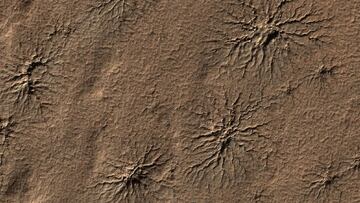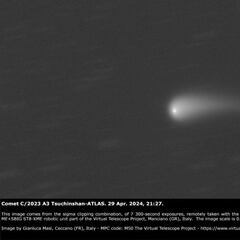Scientists recreate ‘Spiders on Mars’ on Earth: What are the ‘creepy’ arachnid formations?
Space probes captured images of intriguing spider-like formations on Mars, and now NASA scientists on Earth have recreated these huge patterns.


In 2003, scientists first spotted a surprising feature in images taken by orbiters in the southern hemisphere of Mars. Earlier this year, the European Space Agency’s Mars Express probe captured new images of these “spiders.”
Now NASA has recreated these features, dubbed “Spiders on Mars”, that can be found throughout the planet. This geological formation, also known as araneiform terrain, is composed of dark structures that look like cracks, from which hundreds of lines emanate. The resulting pattern appears like spiders scuttering over the Red Planet’s surface.
Scientists eventually determined that these geological formations were the result of seasonal changes on Mars.
READ ALSO: ‘Comet of the century’ to dazzle Earth in fall
Since the giant spider-like features that appear near the poles of #Mars were discovered in 2000, scientists have been working to understand how the strange features arise. New lab experiments appear to validate their prevailing model. Read more: https://t.co/dROMD4Gd6S pic.twitter.com/4UokF55bFS
— Planetary Science Institute (PSI) (@planetarysci) September 24, 2024
Scientists recreate ‘Spiders on Mars’ on Earth: What are the ‘creepy’ arachnid formations?
According to NASA, each branching formation can extend more than a kilometer from end to end and include hundreds of thin “legs.” Known as “araneiformes” for their resemblance to the eight-legged animal, NASA scientists believe that these “spiders” are formed through processes that involve carbon dioxide ice.
In a study later published in The Planetary Science Journal, scientists were inspired by Kieffer’s model to understand the origin of these formations. The hypothesis holds that these cracks appear to form due to the sublimation of carbon dioxide; that is, the process by which a substance passes directly from a solid to a gaseous state, without first going through the liquid state.
“When winter turns to spring and the remaining ice sublimates, the theory goes, what remains are the spider-like scars of those tiny eruptions,” NASA said in a statement.
The co-authors of the research recreated the extreme conditions of the Martian polar surface to understand it, using extremely low atmospheric pressure and temperatures of minus 301 degrees Fahrenheit or -185ºC.
READ ALSO: Eye of a hurricane, the calm in the tempest
Nature ‘a little messier than the textbook image’
Lauren McKeown of NASA’s Jet Propulsion Laboratory and leader of the study used a liquid nitrogen-cooled test chamber at JPL, the Dirty Under-vacuum Simulation Testbed for Icy Environments or DUSTIE. “I love it, it’s historic,” she said of the chamber and the results of their research.
Related stories
Using this tool, they cooled simulated Martian soil in a container immersed in a bath of liquid nitrogen, and placed it in the chamber, where the air pressure was reduced to be similar to that of the southern hemisphere of the planet. The new study showed there was ice within the ground underneath the ice that had formed on the surface. The spiders appear after the ice cracks open allowing gas to escape from the hole. The process leaves behind the arachnid pattern.
“It is one of the details that explains that nature is a little more messy than the textbook image,” McKeown said.


Complete your personal details to comment